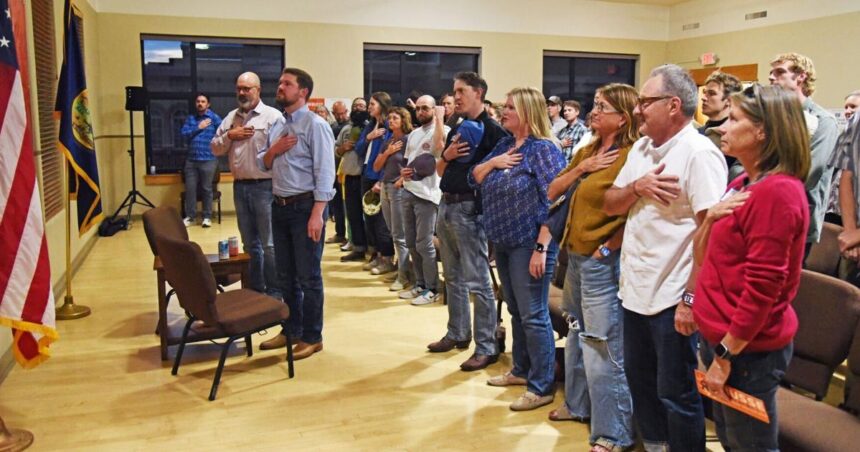The clock is ticking, and election season is almost over. Whether that means no more daily flyers filling mailboxes or TV ads touting and smearing, the results will soon emerge.
While the national media has been significantly less interested in Montana’s local elections, mostly fixated on bullet wounds, PAC money dumps and a reluctance to endorse party leaders, for Montanans prospective leadership has much to solve within the 145,000 square miles of Big Sky Country.
On Wednesday, gubernatorial candidate Ryan Busse stopped by the Chronicle for an interview, having reached out earlier in the week. During the almost 40-minute interview, the Democrat looked at how far he’s come, what issues have mattered most and the money oozing out of campaigns this cycle.
The Chronicle has reached out to Gov. Greg Gianforte to offer a similar opportunity.
This interview has been edited for length and clarity.
Bozeman Daily Chronicle: We’ve got two weeks to go. So, what does it feel like to be Ryan Busse?
Ryan Busse: It’s hectic. It’s exciting. We just had two events in Helena last night with packed houses, so it feels hopeful to me that people are showing up at this late stage of the campaign. I’ve been doing it now for 14 months and last night was our 164th event. We’re pushing 140,000 miles and not seen our own pillows very often, not seen family nearly enough but, man, it’s pretty cool to feel this coming together. We believed from the beginning that we had an incumbent that was very vulnerable and there’s not been a day on the trail where we didn’t feel that was confirmed.
BDC: As you just mentioned, you’ve been crisscrossing the state for months and we can only imagine that you’ve talked to tens maybe hundreds of thousands of people…
RB: I wish hundreds of thousands — we need about 320,000 votes to win so if we could talk to hundreds of thousands that would be good because we wouldn’t have the same advertising problem because we’d convert most of them.
BDC: OK, let’s say thousands.
RB: I’m probably somewhere between 10,000 and 15,000, by the time all these events and town halls are added up.
BDC: We’ll go with that. You’ve talked with thousands of people. What’s the pulse of Montana?
RB: I knew property taxes were a big deal when it all came down and I am continually surprised and shocked at how much property taxes resonate — they’re even more important than I anticipated. I think it’s for two reasons. People are really pissed that they have to pay more property taxes when we had a surplus, and I also think property taxes for this governor, this administration, are illustrative of something bigger. You have a governor who’s disconnected from working people. I mean to him, I don’t think 3,000 or 4,000 bucks in extra property taxes on one of his houses means that much, but to these people, to these voters, it does mean something, and I think it represents to them something bigger, it represents a government that’s disconnected from them and the affordability issue. It’s red hot.
BDC: Is that rise in property taxes emblematic of something bigger at play? A lot of people are moving here, there’s a lot of desire to be in Montana and it seems like the rise in property values and taxes brought that change directly into the wallets of every Montanan.
RB: We have a growing state, and we have a need for services. I think we’ve illegally, maybe unconstitutionally, piled that burden onto homeowners and in effect renters shifting a bunch of burden from industry. There’s this real stress in the population, they feel overtaxed and they feel too much of the burden is on them while they wonder where all the benefit is.
BDC: One Gallatin County Commissioner has said he gets calls and emails from people raising concerns about their property taxes, and sometimes in the same breath, the lack of services available. The commission has also voiced their annoyance with the county’s over-reliance on property taxes and voter-approved mills. So, besides your plan to address the property tax rate, what else can you as governor do to help counties tap into different revenue streams?
RB: I’m not in favor of a statewide sales tax primarily because every proposal I’ve seen on a statewide sales tax is regressive in some way, making it harder on working folks, easier on the wealthy. As governor I promise to never make decisions that do anything approaching that. I think there are some local models like Whitefish’s tourism tax that small communities could use, as long as those programs cannot be regressive.
BDC: What else?
RB: Raph (Graybill) and I are very aware that the structure of our state has changed from one that was heavily reliant on industry, mining and logging that used to drive much of our tax base and now financial services are one of the top industries in Montana. Agriculture is 11. I don’t think a lot of people in the state understand that transformation, but we are in a place that has been transformed into something that it wasn’t 50 years ago. We need leaders in Helena who understand that and can adjust and maybe courageously adjust our taxation system to accommodate that change. It can’t keep being piled on homeowners. It just can’t. It’s what is going to break people. It’s already breaking people.
BDC: We’re not totally sure if most people agree with the changes Montana is going through, it certainly doesn’t always seem like it.
RB: What I’m saying is from a taxation standpoint for the state, the tax base for large industry just isn’t there anymore. We used to have a smaller population and a larger percentage of big industry for taxation. That has reduced and our population has increased. It’s not a matter of the state making that happen or not making it happen. It’s just how the state’s changed.
BDC: When you say that the state’s moving away from industry, maybe even agriculture, is that preventable? Can being a rancher and a farmer still be viable in Montana?
RB: I hope that never goes away — I’m a ranch kid, farm kid — but there are things that the state had nothing to do with regarding ranching and farming. Modernization and efficiencies have hit agriculture because of the profit margin requirements. Where 10 families used to farm X number of acres, one big farming operation with a few guys can do it. That’s nothing that the state did. That’s just the way industry modernized, and it’s put a lot of pressure on small farms or ranches. I think the state should make damn sure it doesn’t do anything to make it any harder. Our property tax proposal rolls back the rates to 2022 levels for all three categories: residential property, small businesses and agriculture, so nobody would pay any more than they did in 2022. Still, some of the agriculture, the changes in agriculture, are far outside the control of the governor. They’re just the way the agriculture industry has changed and modernized.
BDC: The governor’s campaign recently sent us an email that criticized your property tax policy, saying it would “cut property taxes for rich out-of-staters with mansions in the Yellowstone Club by nearly 16%,” “raise property taxes for small businesses by nearly 20%” and “raise property taxes for farmers and ranchers by nearly 10%.” How do you respond to that?
RB: Three words: Lie, lie, lie. Our plan is super clear. It does what the previous four governors have done. Our plan rolls tax rates back for each of the three segments to 2022 levels. It doesn’t increase them on anyone, on any of the three segments, it’s false what they’re saying. After that, we should set ourselves toward the longer-term project of modernizing our tax structure in a way that recognizes the reality of the way the state’s changed.
BDC: You want to drop property taxes down to 2022 rates — what does that mean? Do you want to drop taxable property values back to before the recent reappraisal or the literal taxes collected by the counties in 2022?
RB: I want to drop the state multiplier rate so the assessed values would not change. We can’t go back and tell appraisers what to do on assessed values, but we can control the state multiplier rate, and that’s what the previous four governors have done, two Republicans and two Democrats.
BDC: Let’s zoom out a little farther. There’s a lot of money flowing through Montana this election season. Your race with Gianforte might not amount to the over $140 million in the race between Sen. Jon Tester and Tim Sheehy, but these kinds of numbers are well beyond what the average Montanan will ever experience personally. What does that say about our state?
RB: It’s less about Montana than it is about the national control for the Senate. I talk to (Tester) all the time and he doesn’t like the amount of money being spent. None of us like the money being spent. It’s happening because we’re in this larger national system where the control of Senate is at stake, and were it not for that, we’d still have too much money in our politics. Let’s be honest, it’s disgusting. People are tired of it. I don’t blame them. I’m tired of it. If I could wave a wand and get money out of politics, I’d do it in two seconds. We’re in a dangerous spot with our democracy, and we’re seeing it firsthand here.
BDC: When you look at your race, Gianforte just spent close to $400,000 on TV ads and from your records you’ve spent tens of thousands on advertising. You even spent $16,000 just on thank you cards. Is it even possible to run anymore unless you have that kind of money to spend?
RB: We’re going to raise three and a half million bucks, and we’re very proud of that. Super proud of all the folks who have contributed to that. But it’s hard work. We have a low limit in our race, $1,120 contribution limit. That’s a lot of money, but it’s a low limit, and it’s hard to raise that amount of money from lots and lots of folks.
BDC: Gianforte has significant wealth and you’ve done well for yourself. Can only people with such wealthy backgrounds run for the big races anymore?
RB: We’ve established a political system this very difficult for the average common citizen to run for office and that’s dangerous — it’s getting worse. My wife (Sara) and I were not born with any wealth. It’s an immense personal sacrifice and if you don’t have wealth to do it, it’s almost impossible. We should be very, very concerned about that. There’s a lot of good people that could and should run were it not for this financial requirement.
BDC: What about split-ticket voters? They’re important for Sheehy and Tester — what do they mean to you and your campaign?
RB: This is actually the most hopeful thing that has happened to us. Folks who have lived in Montana for any time know that people here kind of pride themselves on independence and this purple-state thing, and in a time where you could be forgiven for thinking that’s waning, it’s not waning. In our race, there are a lot of people that care more about the place they live in than they do about their national politics. We just did an event in Cardwell a couple nights ago — the population of Cardwell is 56 and there were 83 or 84 people there, so somehow, we doubled the population of Cardwell. The boots that showed up there, I’m pretty damn sure they were in tractors or on horses that day. There were hats that don’t come off heads very often. It’s quite heartening to know that split-ticket voting exists because it tells me they care more about their state than they do about their national politics.
BDC: That might speak to the anecdotal evidence you cited to criticize a recent poll showing you’re down 22 points as not being accurate. What do you make of these polls, especially if you really are seeing split-ticket voters show up at your events?
RB: Nothing we see in the field, nothing, not one shred of anecdotal evidence that we’ve seen on the campaign for 14 months matches up with those national polls. Every single person on our campaign believes we’re going to win every single day or you get off the campaign — that includes me — and so we believe it. We believe it.
BDC: Last one for you: Corner crossing walks a fine line between public access and private property rights…
RB: I don’t think it’s that fine of a line, I beg to differ with you there but keep going.
BDC: You’ve previously said you would support legalizing corner crossing to access stranded public parcels, most often created by checkerboard lands. What’s the solution to the issue? Does it come down to more land swaps with the Forest Service or the Bureau of Land Management? Easements with landowners? Or just outright legalizing jumping those corners?
RB: It’s straight up legalizing corner-crossing. That is your land, my land, it’s everybody’s land and we should have access to it. If it’s blocked that is not a good, equitable, fair situation. We have technology that allows us — almost to the inch — to be able to walk to the corner and step over from one corner of our public land to another. I don’t think that’s a fine line. We should have access to that land. I don’t even view this as controversial, it’s a commonsense thing. Some of that land, however, is landlocked and not accessible by corner-crossing and we should work to develop as many good easements and programs with landowners as possible. This is how Montana operated for a century, but now we have a different class of landowners who see restricting access as profitable or necessary.
BDC: But it does potentially make properties that control access to those public lands more valuable.
RB: It’s not their property. We have a system out of whack if you can restrict access to public land and it increases your value. That’s wrong.





